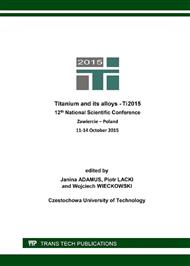[1]
J. Adamus, Applications of titanium sheets in modern building construction, Advanced Materials Research 1020 (2014) 9-14.
DOI: 10.4028/www.scientific.net/amr.1020.9
Google Scholar
[2]
K. Kimura, K. Kinoshita, K. Tokuo et al., Application of titanium to construction, civil engineering and ocean development. Nippon Steel Technical Report No. 85 (2002) 6-10.
Google Scholar
[3]
W. P Ponomariow, I.W. Korablowa, G.D. Gasow, Basic questions concerning the use of alloys, Technology of alloys 5-6 (2001) 159-160.
Google Scholar
[4]
M. Chiba, K. Tokuno, H. Yuagi et al., Applications of titanium to consumer's products and their associated strategy. Nippon Steel Technical Report No. 85 (2002) 15-17.
Google Scholar
[5]
W. I. Alikin , S.W. Ananijn, D.W. Tietjuchin, The latest ideas concerning the use of titanium and its alloys. Titanium 1 (1996) 60-62.
Google Scholar
[6]
Y. Okazasi, Y. Ito, E. Nishimura, Corrosion resistance, medical properties, corrosion fatigue strength and biocompatibility of new Ti alloys V for medical implants, Proc. 9th Word Conf. Titanium'99. Science and Technology, Saint-Petersburg, Russia, 2 (1999).
Google Scholar
[7]
H. Kihira, M. Masaki, H. Shimizu et al., Alumina blast titanium for japans traditional architectures, Nippon Steel Technical Report No. 85(2002) 101-106.
Google Scholar
[8]
W.E. Błaszczuk: Metal and welding in monumental sculptures. Automatic welding. 5 (2002) 46-51.
Google Scholar
[9]
Y. Yamashita, I. Takayama, H. Fuji et al., Application and features of titanium for automotive industry. Ibid, pp.11-14.
Google Scholar
[10]
R. Melechow, K. Tubielewicz, W. Błaszczuk, Titanium and its alloys – species, characteristics, applications, processing technology, and degradation. Publishing of Częstochowa University of Technology. Monographs No. 107 Częstochowa-Poland (2004).
Google Scholar
[11]
J. Adamus, Stamping of the Titanium Sheets, Key Eng. Mat. 410-411 (2009) 279-288.
DOI: 10.4028/www.scientific.net/kem.410-411.279
Google Scholar
[12]
J. Adamus, P. Lacki, Possibility of the increase in titanium sheets' drawability. Key Eng. Mat. 549 (2013) 31-38.
DOI: 10.4028/www.scientific.net/kem.549.31
Google Scholar
[13]
J. Adamus, Theoretical and experimental analysis of the sheet-titanium forming process, Arch Metall Mater. 54/3 (2009) 705-709.
Google Scholar
[14]
J. Adamus, P. Lacki, M. Motyka, K. Kubiak, Investigation of sheet titanium drawability, Proceedings of the 12th World Conference on Titanium Ti 2011, China National Convention Center (CNCC), Beijing, (2011) 337-341. Ed. Science Press Beijing.
Google Scholar
[15]
P. Lacki, K. Adamus, Numerical simulation of welding thin titanium sheets, Key Eng. Mat. 549 (2013) 407-414.
DOI: 10.4028/www.scientific.net/kem.549.407
Google Scholar
[16]
P. Lacki, K. Adamus, P. Wieczorek, Theoretical and experimental analysis of thermo-mechanical phenomena during electron beam welding process, Comp. Mater. Sci. 94 (2014) 17-26.
DOI: 10.1016/j.commatsci.2014.01.027
Google Scholar
[17]
K. Adamus, Z. Kucharczyk, K. Wojsyk, K. Kudla, Numerical analysis of electron beam welding of different grade titanium sheets, Comp. Mater. Sci. 77 (2013) 286-294.
DOI: 10.1016/j.commatsci.2013.05.001
Google Scholar
[18]
J. Adamus, P. Lacki, M. Motyka, EBW titanium sheets as material for drawn parts, Arch. Civ. Mech. Eng. 15 (2015) 42-47.
DOI: 10.1016/j.acme.2014.04.004
Google Scholar
[19]
Rheinzink: http: /www. rheinzink. pl.
Google Scholar
[20]
Ekro Knyż: http: /www. ekro. com. pl.
Google Scholar
[21]
B. Widera, Frank O. Ghery's architecture - stability in variability, Journal of Heritage Conservation, Warsaw 19 (2006) 55-60.
Google Scholar
[22]
Gehry Partners LLP: https: /www. foga. com.
Google Scholar
[23]
J. Rębielak, Numerical models of selected architectural and building solutions. Materials from the 19th International School, Computer-aided design, manufacturing and exploitation (2015) 243-250.
Google Scholar


